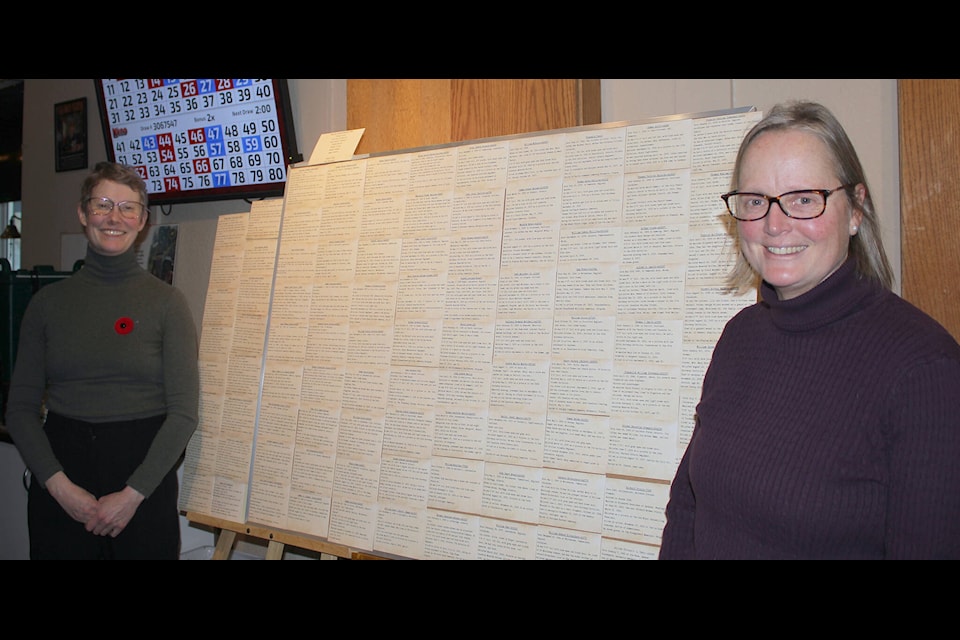A project documenting the intricate lives of First and Second World War veterans listed on the Fernie cenotaph was displayed publicly for the first time on Remembrance Day.
A board filled with historic information on local veterans was placed in the Legion for the public to view as they ate lunch. Reading through the material, attendees were able to get a sense of how each man lived and died.
Sylvia Ayers, a Fernie resident, came up with the idea for the project five years ago. It was the 100th anniversary of the end of the First World War and Ayers felt more needed to be done to commemorate that period of history. She enlisted the help of Fernie Museum curator Lindsay Vallance, who began piecing together information on the men from archival records.
“It’s not just a name. It’s a life, very important stories that are very relevant right now,” said Ayers. “I’ve always believed really strongly that when we know our stories, we value our communities.”
Ayers has always had an interest in history, particularly military history. Her father did military service and worked as a helicopter pilot. As a child, she accompanied him to old battlefield sites in Europe.
“It was ordinary people going off and doing extraordinary things and then coming back to try and pick up a regular life. I find that a very compelling idea,” she said.
Vallance has spent years conducting research, pouring through military records in Library and Archives Canada and then narrowing down the search through the Fernie Census and the Free Press archives. She was able to find information about what each of the men looked like, what their occupations were and the names of their family members.
She has uncovered the lived experience for all but a handful of the men.
“World War One soldiers are actually some of the best documented Edwardian people you can find because they were all weighed and measured,” she explained.
“They have their name, how tall they were, what colour their eyes were, how much they weighed, whether they had any scars or injuries, whether they had good vision. Everything was written down. Every move they made was documented; every time they got on to a ship, every time they got off of a ship, if they were in training,”
Patterns and trends began to emerge through the research.
Vallance found that many of the men lied about their age, either lowering it or increasing it in order to enlist.
She also discovered that some families had multiple war casualties and that their deaths sometimes spanned multiple generations.
Thomas Andrew Ingram and Frank Donald Ingram were brothers who died in the First and Second World Wars, respectively. Thomas served as a private in the 54th Kootenay Battalion and was killed on Sept. 17, 1916 during a raid on enemy trenches at St. Eloi when he was hit with a shell.
Frank, only three years old at the time, later enlisted for service in the Second World War. He was a sapper — a combat engineer — for the 13th Canadian Army Field Company and was killed by an exploding landmine on May 28, 1941 in Shoreham-by-Sea, Sussex and was buried there.
Most of the men, particularly those from the First World War, were fairly short and averaged 5’3” to 5’7”. One man was only five foot and 125 pounds. Vallance said this was mostly due to nutrient deficient diets, but that their careers could have been a factor as well. Many of the men worked in the mines and there were advantages to being short in this profession.
Not everyone died in battle. One man died in a plane crash during a training mission and another in a railway accident. A few died of disease or infection. There was even a man who was shot accidentally by a member of his own unit.
“He picked up a German helmet and put it on as a joke and was shot by a sniper on his own side,” Vallance explained.
Vallance said that if her research has shown her anything, it is that these men were just regular people.
“It’s important to remember them as people,” she said. “We turn them into these idols almost, these exemplars of perfection. They gave their lives. They’re like saints or angels. Whereas, in fact, they were just people and a lot of them died in really horrible ways or just by accident … We have a habit of glorifying the war and forgetting the people whose lives were ended by the war and forgetting their families.”
